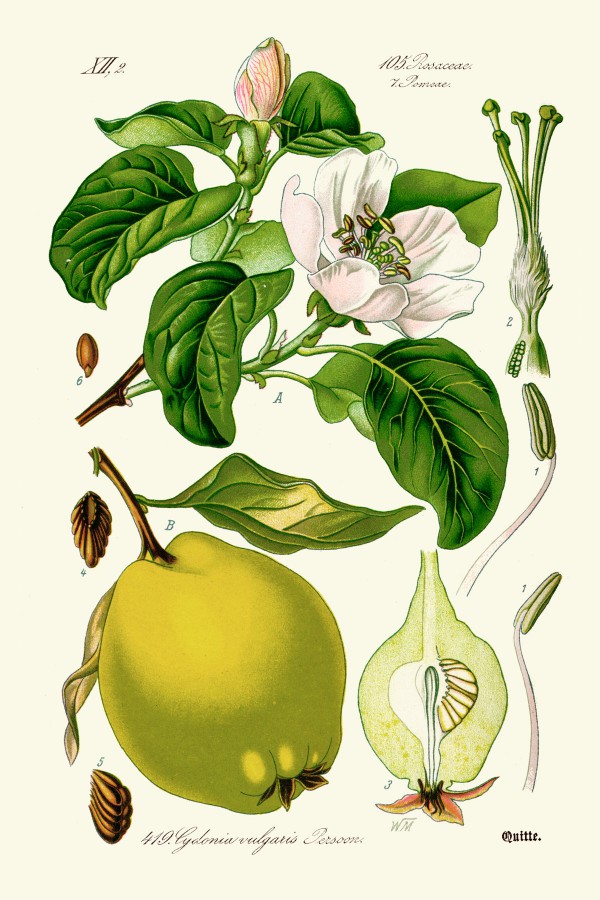Dies ist eine alte Version des Dokuments!
Cydonia oblonga Mill. - Cydonia vulgaris Pers.; Pyrus cydonia L. - Rosaceae - quince, Quitte
Deciduous shrub or small tree, to 8m high, native to West Asia, Caucasus, naturalized and cultivated elsewhere; branchlets purplish red when young, purplish brown when old; leaves ovate to oblong, densely villous; flowers white or pinkish, 4–5 cm in diam.
http://www.efloras.org/florataxon.aspx?flora_id=2&taxon_id=200010815
„Marmelade“ for jam is derived from Portuguese marmelo for quince, from the Greek melimelon „honey apple“.
http://de.wikipedia.org/wiki/Quitte
The essential oil (yield 0.004~0.017%) obtained by steam distillation of fresh C.oblonga from Japan had a strong fruity aroma and consisted mainly of trans-α-farnesene (58%). Furthermore, ethyl esters of saturated and unsaturated fatty acids, like ethyl hexanoate (4.6%), ethyl octanoate 11.2%), ethyl decanoate (4.2%) and ethyl dodecanoate were found (GC/MS).
[The constituents of the essential oil from Japanese quince fruit, Cydonia oblonga Miller., Shimizu, S., Yoshihara, S., Agricultural and Biological Chemistry, Vol.41(8), 1977, 1525-1527]
http://www.tandfonline.com/doi/pdf/10.1080/00021369.1977.10862709
62 compounds were identified in the essential oil (steam distillation) of quince fruit, trans-α-farnesene (31.3%), (+)-trans-marmelo lactone (10.3%) and (-)-cis-marmelo lactone (13.0%) were detected as the major components. The marmelo lactones own a sweet and strong aroma and seem to contribute considerable to the main aroma of quince fruit. Some of the furfural (3.4%) probably is derived from the decomposition of precursors such as pentose and ascorbic acid in the process of steam distillation. The four stereoisomers of megastigma-4,6,8-trien-3-one (2.9%), trans-marmelo oxide (2.4%), cis-marmelo oxide (2.2%), theaspirane (2.9%), theaspirone (1.5%), vitispirane (1.0%), 3,4-dehydro-β-ionone (0.04%) and β-ionone (0.15%) contribute to quince aroma. Only small amounts (2.16%) of fruit esters are present, mostly ethyl caprylate (0.8%), ethyl caproate (0.4%) and cis-3-hexenyl caproate (0.3%).
[Volatile components of quince fruit (Cydonia oblonga Mill.)., Tsuneya, T., Ishihara, M., Shiota, H., Shiga, M., Agricultural and Biological Chemistry, Vol.47(11), 1983, 2495-2502]
http://www.tandfonline.com/doi/pdf/10.1080/00021369.1983.10865983
„Ripe quince fruits are not edible raw because of their hardness and bitterness, but they nevertheless emit a floral odor so strong that they are sometimes used as household room refreshers.“ Oils obtained from the peel of quince fruit consisted mainly (GC 77%) of esters, mostly ethyl esters.
[Volatile constituents of peel of quince fruit, Cydonia oblonga Miller., Umano, K., Shoji, A., Hagi, Y., Shibamoto, T., Journal of Agricultural and Food Chemistry, Vol.34(4), 1986, 593-596]

Thomé, O.W., Flora von Deutschland Österreich und der Schweiz, Tafeln, vol.3 t.419 (1885)
http://www.plantillustrations.org/species.php?id_species=304635
